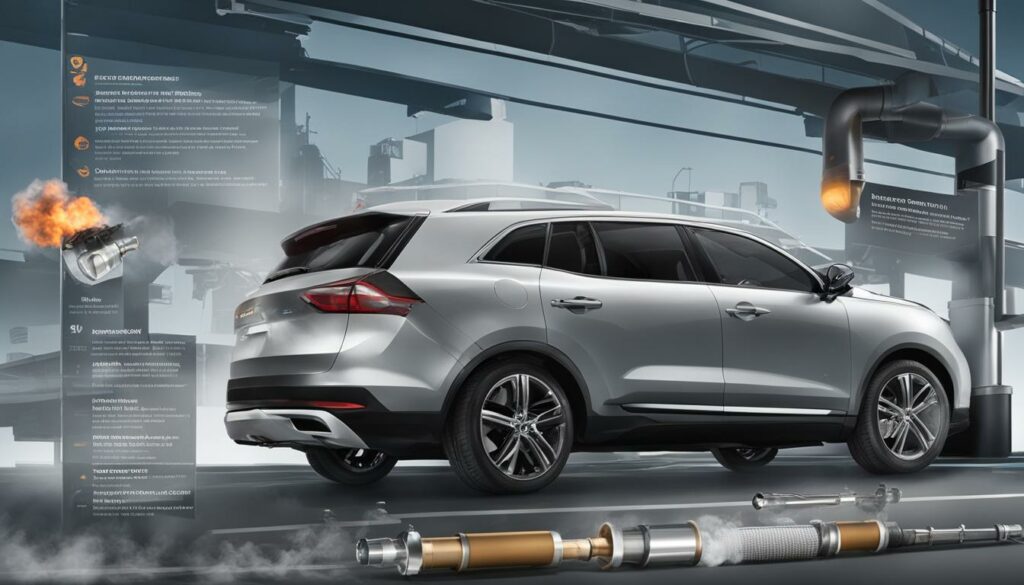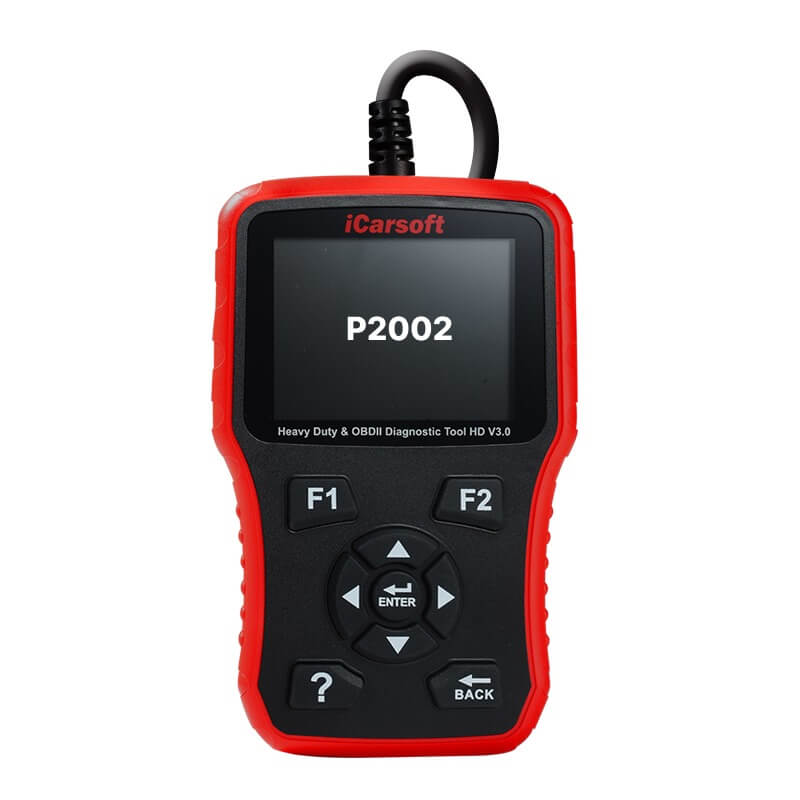P2002 – DPF Efficiency Below Threshold
POSTED IN pcodes
Welcome to our article on the P2002 code – DPF Efficiency Below Threshold. If you own a diesel vehicle, you may have encountered this code and wondered what it means and how it can be resolved. In this article, we will dive into the details of the P2002 code, explore the diesel particulate filter (DPF) and its efficiency, discuss common causes and symptoms, and provide insights on diagnosing and fixing the issue.
Key Takeaways:
- The P2002 code is triggered when the DPF is not working properly, causing a decrease in its efficiency.
- The DPF is an emissions control device in diesel vehicles that filters out soot and eliminates hydrocarbons from the engine exhaust gases.
- Common causes of the P2002 code include DPF failure, exhaust leaks, and excessive slow-speed or stop-and-go operation of the vehicle.
- Symptoms of the P2002 code may include an illuminated check engine light, reduced fuel economy, and poor acceleration.
- Diagnosis of the P2002 code involves visual inspection, test driving with an OBD-II scanner, and monitoring sensor readings.
Understanding the Diesel Particulate Filter
A diesel particulate filter (DPF) is an essential component in the exhaust system of a diesel vehicle. Its primary purpose is to reduce harmful emissions by filtering out soot particles and eliminating hydrocarbons from the engine exhaust gases.
The DPF is designed to resemble a catalytic converter but has the added functionality of self-regeneration. This regeneration process allows the DPF to clean itself by burning off accumulated soot particles, ensuring optimal performance and efficiency.
Regeneration of the DPF typically occurs automatically when the vehicle is driven at higher speeds. The increased exhaust temperatures during these driving conditions facilitate the burning off of the trapped soot particles within the filter. However, if the DPF fails to regenerate efficiently, it may trigger the P2002 code, indicating a problem with the filter’s performance.
To better understand the role of the DPF, let’s take a closer look at how it functions and the process of regeneration.
Buy tested tuning file for Adblue / EGR / DPF / Adblue off now!
How Does the Diesel Particulate Filter Work?
The DPF is composed of a honeycomb-like structure made of ceramic or metallic materials. This structure contains numerous channels or passages that capture soot particles as the exhaust gases pass through it. These trapped particles are then periodically burned off through a process known as regeneration.
Regeneration involves raising the temperature of the DPF to a point where the accumulated soot particles turn into ash, effectively resetting the filter’s efficiency. When the DPF is operating optimally, the soot particles are burned off, maintaining a clean filter and minimizing emissions.
The Process of DPF Regeneration
DPF regeneration is typically divided into two main types: passive and active regeneration.
Passive regeneration occurs during normal driving conditions when exhaust temperatures reach the necessary threshold for self-cleaning. This process relies on higher speeds and longer journeys to maintain optimal DPF efficiency.
Active regeneration is initiated by the vehicle’s engine management system when it detects that the filter needs cleaning. During active regeneration, the engine control unit injects additional fuel into the exhaust system, increasing temperatures to facilitate the combustion of the trapped soot particles. This process can often be noticed by the driver through a slight increase in fuel consumption or a change in engine sound.
The Importance of DPF Regeneration
Proper DPF regeneration is crucial for maintaining good engine performance, fuel efficiency, and emissions control. Without regular regeneration, the DPF can become clogged with soot, leading to restricted exhaust flow, decreased fuel efficiency, and potentially triggering the P2002 code.
In addition, a poorly functioning DPF can have detrimental effects on the entire exhaust system, including the turbocharger and other engine components. By ensuring that the DPF properly regenerates, you can extend the lifespan of your vehicle’s exhaust system and reduce the risk of costly repairs.
| Benefits of DPF Regeneration | Consequences of Inefficient Regeneration |
|---|---|
| 1. Reduced soot emissions | 1. Increased risk of DPF failure |
| 2. Improved fuel efficiency | 2. Restricted exhaust flow |
| 3. Extended exhaust system lifespan | 3. Decreased engine performance |
| 4. Prevented damage to engine components | 4. Higher fuel consumption |
Understanding the diesel particulate filter and the importance of efficient DPF regeneration is crucial for diesel vehicle owners. By staying informed and taking proactive measures to maintain the DPF’s performance, you can enjoy cleaner emissions, improved fuel economy, and a longer-lasting exhaust system.
Common Causes of the P2002 Code
When it comes to the P2002 code, there are several common causes that can trigger it. Understanding these causes is crucial to diagnosing and addressing the issue effectively. The most frequent culprits behind the P2002 code include:
- DPF Failure or Damage: A faulty or damaged diesel particulate filter (DPF) can lead to the P2002 code. The DPF is responsible for trapping and reducing harmful emissions, but if it becomes clogged or fails to function properly, the code can be triggered.
- Exhaust Leak: An exhaust system leak can also cause the P2002 code. When there is a leak in the exhaust system, it can allow unfiltered exhaust gases to escape, affecting the DPF’s efficiency.
- High Sulfur Content Fuel: The use of fuels with a high sulfur content can contribute to the P2002 code. High sulfur levels can contaminate the DPF and hinder its ability to function optimally.
- Excessive Slow-Speed or Stop-and-Go Operation: Prolonged periods of slow-speed or stop-and-go driving can limit the DPF’s regeneration process. Insufficient regeneration can lead to clogging and inefficiency, triggering the P2002 code.
- Vehicle Software Issues: While rare, problems with the vehicle’s software can also be a potential cause. Faulty software can disrupt the proper functioning of the DPF and trigger the P2002 code.
Understanding these common causes will help you narrow down the potential issues when troubleshooting the P2002 code. Identifying the root cause is crucial to ensuring a proper and effective repair.

| P2002 Code Causes | Description |
|---|---|
| DPF Failure or Damage | A faulty or damaged DPF can trigger the P2002 code. Regular maintenance and inspection of the DPF can help prevent issues. |
| Exhaust Leak | An exhaust system leak can disrupt the DPF’s efficiency and trigger the P2002 code. Proper sealing and repair of any leaks is essential. |
| High Sulfur Content Fuel | Fuels with high sulfur content can contaminate the DPF and impair its function, resulting in the P2002 code. Using low-sulfur fuel is recommended. |
| Excessive Slow-Speed or Stop-and-Go Operation | Extended periods of slow-speed or stop-and-go driving can limit the DPF’s regeneration process, leading to clogging and triggering the P2002 code. Regular highway driving can help prevent this. |
| Vehicle Software Issues | While uncommon, software issues can disrupt the DPF’s operation and trigger the P2002 code. Consult with a professional mechanic or dealership for software-related concerns. |
Symptoms of the P2002 Code
The P2002 code can manifest with several symptoms, indicating potential issues with your vehicle’s diesel particulate filter (DPF) efficiency. If you encounter any of these symptoms, it is essential to address the problem promptly to restore proper engine performance and prevent further damage.
1. Illuminated Check Engine Light
One of the most common symptoms of the P2002 code is an illuminated check engine light on your vehicle’s dashboard. This warning indicator is designed to alert you of potential issues with your vehicle’s engine or emissions system, prompting the need for immediate attention.
2. Reduced Fuel Economy
Reduced fuel economy is another symptom associated with the P2002 code. As the DPF efficiency drops, the engine may work harder to compensate, resulting in increased fuel consumption. If you notice that your vehicle’s fuel efficiency has significantly decreased, it may be an indication of a DPF malfunction.
3. Poor Acceleration
A malfunctioning DPF can impact your vehicle’s acceleration performance. You may experience a lack of power or sluggishness when trying to accelerate. This can be attributed to the restricted exhaust flow caused by a clogged or inefficient DPF.
4. Difficulty in Starting the Vehicle
In some cases, the P2002 code may cause difficulties in starting the vehicle. This can occur when the DPF is severely clogged, hindering the proper flow of exhaust gases and affecting the combustion process.
5. Engine Oil Dilution
If the DPF fails to regenerate and soot builds up inside the filter, the engine management system may attempt to increase the temperature of the exhaust to burn off the accumulated soot. During this process, excess fuel can find its way into the engine oil, leading to oil dilution. Oil dilution can reduce lubrication effectiveness and potentially cause engine damage if left unaddressed.
If you experience any of these symptoms, it is recommended to have your vehicle inspected by a qualified mechanic. They can diagnose the underlying issue and perform the necessary repairs to resolve the P2002 code and restore your vehicle’s performance.
| Symptom | Description |
|---|---|
| Illuminated Check Engine Light | An indicator light on the vehicle’s dashboard that alerts the driver to potential engine or emissions system issues. |
| Reduced Fuel Economy | A decrease in the vehicle’s fuel efficiency, resulting in the consumption of more fuel to maintain proper performance. |
| Poor Acceleration | A lack of power or sluggishness when attempting to accelerate, indicating engine performance issues. |
| Difficulty in Starting the Vehicle | Problems encountered when starting the vehicle due to restricted exhaust flow caused by a clogged or inefficient DPF. |
| Engine Oil Dilution | The presence of excess fuel in the engine oil, potentially leading to reduced lubrication effectiveness and engine damage. |
Diagnosing the P2002 Code
Diagnosing the P2002 code can be challenging due to its various possible causes. It is strongly recommended to have a professional mechanic perform the diagnosis to ensure accurate results and prevent further damage to your vehicle. A comprehensive diagnostic process will involve a visual inspection of the Diesel Particulate Filter (DPF) and the exhaust back pressure sensor, as well as a test drive with an OBD-II scanner connected to monitor sensor readings.
During the visual inspection, the mechanic will carefully examine the DPF for signs of clogging, damage, or leaks. They will also check the exhaust back pressure sensor, which helps determine the efficiency of the DPF. Any abnormalities or malfunctions in these components can contribute to the triggering of the P2002 code.
Next, the mechanic will take your vehicle for a test drive while monitoring the sensor readings using an OBD-II scanner. This device allows them to gather real-time data and identify any discrepancies or irregularities in the DPF’s performance. It is crucial to pay attention to the readings from both banks of cylinders. If significant differences are detected between the two banks, further troubleshooting may be required before determining whether the DPF needs to be replaced.
Image: P2002 code diagnosis using visual inspection, test drive, and OBD-II scanner.
By employing a combination of visual inspection, test drive, and OBD-II scanner readings, a professional mechanic will be able to accurately diagnose the P2002 code and identify the underlying issue affecting the DPF’s efficiency. These diagnostic methods provide crucial insights into the condition of your vehicle’s emission control system, enabling targeted repairs and ensuring optimal performance.
Fixing the P2002 Code
When confronted with a P2002 code, the appropriate repair method will vary depending on the underlying cause. The following are some potential remedies:
- Clearing the DPF through a regeneration process: The first step in addressing a P2002 code is attempting to clear the diesel particulate filter (DPF) using a regeneration process. This involves raising the exhaust temperature to facilitate the combustion of accumulated soot. Regeneration can be accomplished through either passive regeneration, which occurs during highway driving, or active regeneration, which involves using a diagnostic tool or software to initiate the process.
- Changing the diesel fuel to a higher-quality option: Using a low-quality or contaminated diesel fuel can contribute to DPF inefficiency. Switching to a higher-quality fuel with lower sulfur content can help prevent clogging and improve the DPF’s performance.
- Replacing the DPF if it is damaged or clogged: If the DPF is severely damaged or excessively clogged, clearing it through regeneration may not be sufficient. In such cases, replacement is often necessary to restore DPF efficiency. Ensure that the new DPF meets the specifications of your vehicle’s make and model.
- Replacing the exhaust back pressure sensor if it is faulty: The exhaust back pressure sensor plays a crucial role in monitoring DPF performance. A malfunctioning sensor can inaccurately detect the pressure levels within the exhaust system, leading to a P2002 code. If the sensor is determined to be faulty during diagnosis, replacement can resolve the issue.
It is vital to follow proper diagnostic and repair procedures to effectively fix the P2002 code and restore the DPF’s efficiency.
For visual reference, the table below summarizes the potential repair options for addressing the P2002 code:
| Repair Option | Description |
|---|---|
| Clearing the DPF through a regeneration process | Initiate a regeneration process to burn off accumulated soot and restore DPF efficiency |
| Changing the diesel fuel to a higher-quality option | Switching to a fuel with lower sulfur content to prevent clogging and enhance DPF performance |
| Replacing the DPF | Install a new DPF if the existing one is severely damaged or excessively clogged |
| Replacing the exhaust back pressure sensor | Install a new sensor if it is determined to be faulty during diagnosis |

Considering Professional Assistance
If professional assistance is not readily available or if you prefer an alternative solution, there are options for permanent removal of the P2002 code. One alternative is to upload your Engine Control Unit (ECU) file to a specialized portal. This can be done when professional assistance is not accessible and may provide a solution for resolving the issue permanently.
Conclusion
Dealing with a P2002 code can be frustrating, but there are steps you can take to resolve the issue. It is crucial to follow the troubleshooting steps outlined by a professional mechanic to pinpoint the exact cause of the problem. Once the issue has been identified, you can explore the available repair options that best suit your situation.
Whether it involves clearing the DPF through a regeneration process, using higher-quality diesel fuel, or replacing components like the DPF or back pressure sensor, addressing the P2002 code promptly is essential to ensure the efficient operation of your diesel vehicle.
Remember, proper diagnosis and repair are crucial to resolving the P2002 code. Seek professional assistance if needed and rely on the expertise of trained mechanics to guide you through the process. By taking the necessary steps to resolve the P2002 code, you can restore the performance and optimize the longevity of your diesel vehicle.
FAQ
What does the P2002 code mean?
The P2002 code stands for “Diesel Particulate Filter Efficiency Below Threshold (Bank 1).” It is triggered when the computer detects that the diesel particulate filter (DPF) is not working properly.
What is a diesel particulate filter (DPF)?
The diesel particulate filter (DPF) is an emissions control device located in the exhaust system of a diesel vehicle. Its purpose is to physically filter out soot and eliminate hydrocarbons from the engine exhaust gases through catalyst reactions.
What are the common causes of the P2002 code?
The most common causes of the P2002 code include DPF failure or damage, an exhaust leak, excessive slow-speed or stop-and-go operation of the vehicle, and the use of fuels with high sulfur content.
What are the symptoms of the P2002 code?
Symptoms of the P2002 code can include an illuminated check engine light, reduced fuel economy, difficulty in starting the vehicle, poor acceleration, and engine oil dilution.
How is the P2002 code diagnosed?
Diagnosing the P2002 code typically involves a visual inspection of the DPF and the exhaust back pressure sensor, as well as a test drive with an OBD-II scanner connected to monitor sensor readings.
How is the P2002 code repaired?
The repair for the P2002 code will depend on the specific cause. Possible repairs include clearing the DPF through a regeneration process, changing the diesel fuel to a higher-quality option, replacing the DPF if it is damaged or clogged, and replacing the exhaust back pressure sensor if it is faulty.
Should I consider professional assistance for the P2002 code?
It is recommended to have a professional mechanic perform the diagnosis and repair for the P2002 code. However, there are alternative solutions available, such as uploading the Engine Control Unit (ECU) file to a specialized portal, when professional assistance is not readily accessible.
What is the importance of addressing the P2002 code promptly?
Addressing the P2002 code promptly is important to restore the efficiency of the diesel particulate filter (DPF) and ensure the efficient operation of your diesel vehicle.


